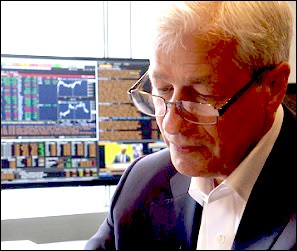by Pam Martens and Russ Martens, Wall St On Parade:

According to the Federal Deposit Insurance Corporation (FDIC), there were 4,706 federally-insured banks and savings associations in the U.S. as of December 31, 2022. Of those, according to the quarterly report released last Friday from the Office of the Comptroller of the Currency (OCC), a little less than one-quarter found a reason to engage in derivative trading activities.
As of December 31, 2022, just 1,139 FDIC-insured commercial banks and savings associations reported trading of derivatives in the fourth quarter of 2022, according to the OCC. Ostensibly, instead of running a derivatives casino, the other three-quarters of taxpayer-subsidized banks were doing what taxpayers want federally-insured banks to do: make business loans; provide affordable mortgage loans to homebuyers; provide checking accounts devoid of hacking, identity theft and predatory overdraft fees; and not blow up the bank by getting in bed with derivatives, crypto or dodgy Wall Street IPOs.
TRUTH LIVES on at https://sgtreport.tv/
As it does each quarter, the OCC report rang this alarm bell:
“A small group of large financial institutions continues to dominate trading and derivatives activity in the U.S. commercial banking system. During the fourth quarter of 2022, four large commercial banks represented 88.2 percent of the total banking industry notional amounts [of derivatives] and 62.5 percent of industry net current credit exposure (NCCE).”
Those four banks are Goldman Sachs Bank USA with $52.6 trillion in notional (face amount) derivatives exposure; JPMorgan Chase Bank N.A. with $49.5 trillion in notional derivatives exposure; Citigroup’s Citibank with $47 trillion in notional derivatives exposure; and Bank of America with $19.4 trillion in notional derivatives exposure.
One area that particularly stands out in the current OCC report is data showing JPMorgan Chase Bank N.A. held $200.12 billion in precious metals derivative contracts at its federally-insured bank as of December 31, 2022, versus a total of $378.12 billion for all banks in the U.S. holding derivatives. That’s one bank holding 53 percent of all precious metals contracts in the U.S. banking system. (See Table 21 on page 26 of the OCC report.)
And there’s no guarantee that the OCC report captures the full picture of this highly concentrated derivatives market. (See our report: Wall Street Banks Are Dangerously Evading U.S. Derivatives Rules by Making Trades at Foreign Subsidiaries.)
It is hard to understate the regulatory failure of allowing JPMorgan Chase to continue to have this outsized presence in the precious metals derivatives market.
On September 29, 2020, the U.S. Department of Justice charged JPMorgan Chase with rigging the precious metals market and a hit it with a criminal felony count for its conduct, to which it admitted. According to the Justice Department, the rigging occurred for more than eight years, from March of 2008 to August of 2016, and involved “tens of thousands” of incidents. The Justice Department wrote that traders at JPMorgan Chase:
“…knowingly and intentionally placed orders to buy and sell precious metals futures contracts with the intent to cancel those orders before execution (‘Deceptive PM [Precious Metals] Orders’), including in an attempt to profit by deceiving other market participants through false and fraudulent pretenses and representations concerning the existence of genuine supply and demand for precious metals futures contracts. By placing Deceptive PM Orders, the Subject PM Traders intended to inject false and misleading information about the genuine supply and demand for precious metals futures contracts into the markets, and to deceive other participants in those markets into believing something untrue, namely that the visible order book accurately reflected market-based forces of supply and demand. This false and misleading information was intended to, and at times did, trick other market participants, including competitor financial institutions and proprietary traders, into reacting to the apparent change and imbalance in supply and demand by buying and selling precious metals futures contracts at quantities, prices, and times that they otherwise likely would not have traded.”
The trading conduct in precious metals was so bad at JPMorgan Chase that the Justice Department took the unprecedented step of charging some of the precious metals traders involved under the Racketeer Influenced and Corrupt Organizations Act (RICO), a statute typically reserved for organized crime figures.
Last week, the Senate Banking Committee and the House Financial Services Committee held separate hearings on the bank runs and abrupt collapses of Silicon Valley Bank and Signature Bank in March, the second and third largest bank failures in U.S. history. (The largest bank failure was Washington Mutual in 2008.) Those banks, respectively, held $175 billion and $88.6 billion in deposits as of December 31, 2022. As of the same date, JPMorgan Chase Bank N.A. held $2.015 trillion in deposits in domestic offices, of which $1.058 trillion were uninsured.
Uninsured deposits are at risk of flight if customers lose confidence in the management of a bank. The fastest way for depositors to lose confidence in a bank is a steady stream of scandals and criminal conduct while the Board of Directors of the bank fails to replace the Chairman and CEO who was at the helm of the bank throughout the endless series of scandals and criminal conduct.
The Board of Directors of JPMorgan Chase Bank have allowed Jamie Dimon to remain as Chairman and CEO despite five felony counts (to which the bank admitted) and a rap sheet that is unprecedented in the annals of banking in the U.S.
Read More @ WallStOnParade.com



